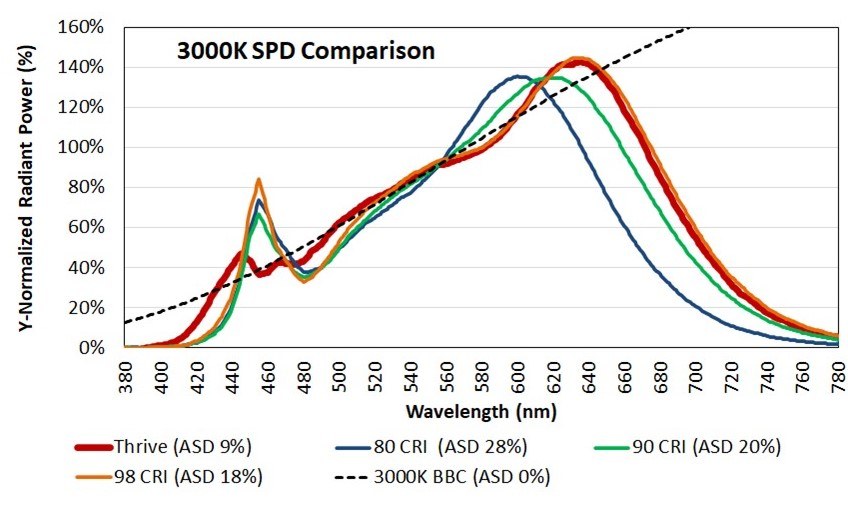Bridgelux Develops a New Metric to Quantify the Naturalness of Light
Bridgelux today announced development of a new metric to enable objective comparisons of light sources to natural light. With the growing market interest in human-centric lighting, the question of “naturalness” of light source spectra is becoming a frequently asked question. Standard lighting quality metrics such as CRI and TM-30 do not fully address the naturalness question. The Average Spectral Difference (ASD) metric has been developed by Bridgelux to address this shortcoming in available light quality metrics.
Throughout evolution, the human visual system has evolved under the natural light of sun and fire. These light sources have standardized industry spectral power definitions that describe the state of natural light. Lighting specifiers, designers, and luminaire manufacturers regularly consider color quality metrics such as CRI and TM-30, as well as individual spectral power distributions (SPDs), when making decisions regarding light source selection. However, until now, there has been no metric that quantifies the naturalness of a light source. ASD provides an objective quantitative measurement of how closely a light source matches natural light over the visible spectrum, averaging the differences of the spectral peaks and valleys between a light source and a standardized natural light source of the same CCT.
Unlike CRI and TM-30, where higher values indicate higher quality light, ASD represents the difference in spectra compared to natural light. Therefore, the lower the ASD value, the closer the match to natural light. The Bridgelux ThriveTM LED light source family has been engineered to provide the closest match to natural light available in the market.
Standard lighting quality metrics and ASD values for natural light and LED light sources available from Bridgelux at 3000K are:
- Natural Light: Ra 100, Rf 100, Rg 100, ASD 0%
- Thrive: Ra 98, Rf 98, Rg 101, ASD 9%
- Bridgelux Décor 97 CRI: Ra 98, Rf 94, Rg 102, ASD 18% (100% higher than Thrive)
- Bridgelux 90 CRI: Ra 92, Rf 91, Rg 97, ASD 20% (120% higher than Thrive)
- Bridgelux 80 CRI: Ra 83, Rf 84, Rg 93, ASD 28% (210% higher than Thrive)
The ASD values for standard light sources are much larger compared to Thrive, including the 98 CRI light source which has similar CRI and TM-30 Rg values. While TM-30 and CRI are important color quality metrics, having high values does not necessarily correspond to high naturalness of the light source, whereas having very low ASD values always corresponds to high naturalness.
“The market is evolving to human-centric lighting,” said Brian Cumpston, VP Solutions Development of Bridgelux. “While there are several approaches to developing human-centric lighting solutions, delivering the closest match to natural light is of great interest to our customers. Thrive has been developed to address this demand, and the new ASD metric developed by Bridgelux provides an objective and quantitative way to compare light sources and determine how closely they match the spectra of natural light. We hope this new metric will be broadly adopted in the lighting industry to provide new insight into naturalness beyond CRI and TM-30.”
Bridgelux has authored a white paper further explaining the background behind the ASD metric which is now available for download from the Bridgelux web site.
For more information, please visit https://www.bridgelux.com

